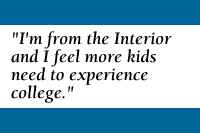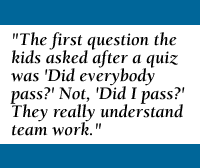Galena health academy saves lives and communities
August 2004
By Marie Gilbert, Institute of Arctic Biology for College of Rural and Community Development
![[Margaret Wilson]](/news/archives/news-archives-2002-2010/featured/04/galena/images/body1.jpg) For 14 Interior village high school students, the Galena Summer Health Academy was
no laid-back summer camp.
For 14 Interior village high school students, the Galena Summer Health Academy was
no laid-back summer camp.
During the camp's three weeks, high school students from Anvik, Galena, Grayling, Huslia, Nulato, Ruby and Russian Mission pretended to rescue babies from burning buildings while blindfolded; learned to perform CPR and emergency first aid; rappelled off a water tower; practiced fire, water and ice rescue techniques; and heard from registered nurses, physician assistants and clinic managers about health careers.
The academy, developed by Margaret Wilson of the University of Alaska Fairbanks College of Rural Alaska, was held at the Galena project education residential school June 7-25, 2004, and is part of the school's health education early discovery program.
The academy encourages village high school students to seek careers in health-related fields, use their new skills by working with health aides and fire departments in their home villages, and earn college credit.
 It takes villages and a few Dragon Slayers
It takes villages and a few Dragon Slayers
"Tribal elders, educators and health-care professionals in the Galena area noticed
that fewer high school students were continuing their education past high school,
unlike the previous generation," said Sue Hills, outreach core director for the University
of Alaska IDeA Network of Biomedical Research Excellence (INBRE).
"I'm from the Interior and I feel more kids need to experience college," said Wilson, a CRA instructor.
"Part of my job was to develop a summer academy," Wilson said. "We got one going in Kotzebue last May and in July (2003) I visited Pete Brown's Aniak Dragon Slayer camp. We talked about working together so the kids could get college credit and the program could be more in-depth."
![[Participants test their skills at finding dolls in a 'burning' building.]](/news/archives/news-archives-2002-2010/featured/04/galena/images/body2.jpg) Brown is Aniak's volunteer fire chief and leader of the well-known all-girl Aniak
Dragon Slayers fire rescue team.
Brown is Aniak's volunteer fire chief and leader of the well-known all-girl Aniak
Dragon Slayers fire rescue team.
With funding from INBRE, Wilson brought Brown and Dragon Slayers Falina Morris, Mary Turner and Amber Vaska to the Galena academy to teach a week of fire, water and ice rescue skills and help teach a 60-hour emergency trauma training (ETT) course-the same training required of fire and police personnel. INBRE is funded by the National Center for Research Resources at the National Institutes of Health and encourages students in high school and college to consider careers in health and science.
"These kids had no idea what they were getting into," Brown said with a chuckle. "They
had no idea how intense it would be. They thought it would be three easy weeks.  The first couple days of ETT they were a little overwhelmed. By the second day they
were getting into it and by week three we really had 'em."
The first couple days of ETT they were a little overwhelmed. By the second day they
were getting into it and by week three we really had 'em."
Career options in health
"I wanted to show the kids that if they're thinking of taking college courses and
staying home there are options available," Wilson said. For example, a student from
Aniak earned a certificate in phlebotomy without leaving her home village.
During the first week students put in six 10-hour days exploring different health careers.
![[Sue Hills gets ready to take her turn rapelling off the Galena water tower.]](/news/archives/news-archives-2002-2010/featured/04/galena/images/body3.jpg) Robin Wahto of the University of Alaska Anchorage Allied Health Program presented
long-distance education opportunities in radiology and medical technologies. Tanana
Chiefs Conference registered nurse Josephine Malemute and the director of TCC's Office
of Environmental Health, Pete Wallis, shared career stories and experiences with the
students. Students also heard presentations from a physician assistant, health aide,
billing clerk, clinic manager and a mammographer.
Robin Wahto of the University of Alaska Anchorage Allied Health Program presented
long-distance education opportunities in radiology and medical technologies. Tanana
Chiefs Conference registered nurse Josephine Malemute and the director of TCC's Office
of Environmental Health, Pete Wallis, shared career stories and experiences with the
students. Students also heard presentations from a physician assistant, health aide,
billing clerk, clinic manager and a mammographer.
"As part of the requirements the students wrote a formal paper, for two college credits, comparing a health career with another career they were thinking about and presented that paper to the group," Wilson said. "I wanted them to compare education requirements, credentialing, recertification, working conditions, duties and responsibilities, salary, and overall advantages and disadvantages."
Students were graded on their participation in class, the questions they posed to guest speakers and a journal of their thoughts and feelings about the program.
 Teamwork tames trauma
Teamwork tames trauma
"The thing that impresses me the most about Alaskans and Alaska Natives is that they
understand team work," said Shiloh Lightfoot, ETT instructor and owner of Alaskan
Emergency Medical Training Service.
"Cooperation is part of village life. The first question the kids asked after a quiz was 'Did everybody pass?' Not, 'Did I pass?' They really understand team work," Lightfoot said.
"We did lots of hands-on training and moulage-practice scenarios where you have a patient to assess and manage appropriately-with fake blood, fake bruises and fake wounds during the second week of the academy," said Lightfoot.
Students who passed the 60-hour course earned three college credits through UAF's Emergency Services Program.
"These kids were great, easily equal to any adult class I've had," said Lightfoot.
![[Jon Kangas and Aniak Fire Chief Pete Brown assemble fire helmets.]](/news/archives/news-archives-2002-2010/featured/04/galena/images/body4.jpg) Fire, water and ice
Fire, water and ice
The third week featured what Brown called, "kick ash" fire rescue. "We taught them
how fire burns, how it spreads and how bad things like flashovers and backdrafts happen.
We taught them how to make a rescue from land and from shore, when to make it and
when not to. But mostly, we're helping them develop the self-confidence to do it safely
and the knowledge that kids can make a difference."
"The Galena Air Force Base fire department helped out by setting fires in their training building and all the kids had to handle the fire hose and feel the heat," Brown said.
"We want them to know how to make a difference in their community without a fire department," Brown said.
Part of that difference comes from "emphasizing personal responsibility rather than punishment," said Jodie Hettrick, public education coordinator for the Alaska State Fire Marshal's office. Hettrick taught a fire prevention course at the academy.
"The teenagers in villages can tell other kids to behave, and the kids listen to them," Hettrick said.
"Seventy-five percent of our child fire fatalities in Alaska are two- to three-year-olds playing with matches and lighters," Hettrick said. "We can take advantage of the relationship between teens and other children by teaching teens which fire prevention lessons are appropriate for which ages."
"The most important thing that's happening because of the Aniak Dragon Slayers and the Galena Summer Health Academy is that kids learn they can make a difference by learning skills in their own communities. They don't have to go to Anchorage or Fairbanks," Hettrick said.
Academy support
Funding for the Galena Summer Health Academy came from the Tanana Chiefs Conference
Galena subregion, the TCC wellness program, the UAF College of Rural Alaska and the
UA INBRE program.
![[Leanne Bifelt]](/news/archives/news-archives-2002-2010/featured/04/galena/images/sidebar1.jpg)
![[Adele Stickman]](/news/archives/news-archives-2002-2010/featured/04/galena/images/sidebar2.jpg)
![[Jana Demoski and Sean Wolf]](/news/archives/news-archives-2002-2010/featured/04/galena/images/sidebar3.jpg)
![[Students 'feel the heat']](/news/archives/news-archives-2002-2010/featured/04/galena/images/sidebar4.jpg)
![[Galena Summer Health Academy group picture]](/news/archives/news-archives-2002-2010/featured/04/galena/images/sidebar5.jpg)
For more information please contact:
- College of Rural Alaska
- Marie Gilbert, publications and information coordinator, Institute of Arctic Biology, University of Alaska Fairbanks, (907) 474-7412, marie.gilbert@uaf.edu.
- Margaret Wilson, College of Rural Alaska instructor, Galena Summer Health Academy organizer; (907) 474-7420, ffmmw@uaf.edu.
- Pete Brown, fire chief Aniak Fire Rescue, leader Aniak Dragon Slayers, (907) 675-4601, avfdchief@yahoo.com.
- Shiloh Lightfoot, owner Alaskan Emergency Medical Training Service, aemts@mosquitonet.com.
- Sue Hills, outreach core director for the IDeA Network for Biomedical Research Excellence (INBRE), University of Alaska Fairbanks, (907) 474-5106, shills@ims.uaf.edu, www.alaska.edu/epscor/ and www.alaska.edu/brin/.
- George Happ, director of Alaska INBRE, University of Alaska Fairbanks, (907) 474-5492, ffgmh@uaf.edu.
- Jodie Hettrick, public education coordinator, Alaska State Fire Marshal's Office, (907) 269-5052, www.dps.state.ak.us/fire/asp/publiceducation.asp.
Photos courtesy College of Rural Alaska


